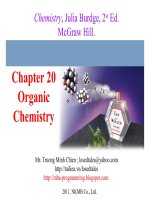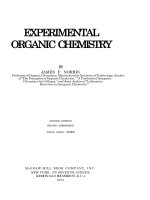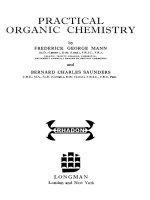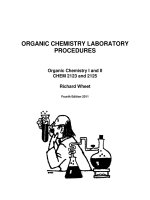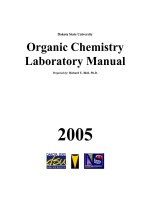Organic chemistry 1105
Bạn đang xem bản rút gọn của tài liệu. Xem và tải ngay bản đầy đủ của tài liệu tại đây (597.23 KB, 42 trang )
Organic Chemistry
The unique chemistry
of carbon
Learning objectives
Describe two reasons for abundance of carbon
compounds
Distinguish between inorganic and organic
carbon and other compounds
Distinguish between isomers and non-isomers
Describe differences between optical and
geometric isomerism
Distinguish between aromatic and nonaromatic
Identify common functional groups
One element – one branch of
chemistry
Organic compounds based on
carbon: 13 million and rising (fast)
100,000 new compounds synthesized
annually
All 91 other elements combined:
only 300,000 compounds
Factoids about carbon
Fairly abundant in earth’s crust – but
not enough to explain domination
Highly significant to life
Key element in the human organism –
and all others
“God’s goof”:
The absence of stable mass 5
C and O are abundant because the atom with
mass 5 is unstable
Otherwise atom building after the Big Bang
would have resulted in much heavier elements
The thoughts of a cosmological atheist Fred
Hoyle:
“Some supercalculating intellect must have designed the
properties of the carbon atom, otherwise the chance of my
finding such an atom through the blind forces of nature
would be utterly minuscule….The numbers one calculates
from the facts seem to me so overwhelming as to put this
conclusion almost beyond question”
Organic and inorganic carbon
Inorganic carbon: ionic compounds
where carbon is incorporated as
carbonate – CO32Organic carbon: compounds of
carbon with itself, hydrogen and
other elements – by far the most
important
Organic carbon forms a thin canopy
Unique (?) conditions on earth that
support life
Earth’s
surface organic
Earth’s
crust inorganic
Vitalism and organic chemistry
Inorganic compounds were salts of the earth
Stable and easily synthesized
Organic compounds were of living organisms
Fragile and not easily synthesized
Belief in Vitalism posited that only living
organisms possessed a vital force necessary to
create organic compounds
In 1828 urea was synthesized and vitalism was
on the way out
Seven ages of man - many ages of a
carbon atom
Combustion: C + O2 CO2
Neutralization by seawater: CO2 + Ca(OH)2 CaCO3 + H2O
Reaction with acid rain: CaCO3 + H2SO4 CO2
Photosynthesis: CO2 Organic compounds (OC)
Vegetation decomposes: OC fossil fuels (FF)
Vegetation consumed by animal: OC new compounds
(proteins, DNA etc.)
Respiration: sugars CO2 + energy
Industrialization: FF C, CO2 + energy
Manufacturing: FF Plastics, polymers, drugs etc.
Waste disposal Fossil fuels, CO2
Two reasons why carbon is unique
Carbon can form four bonds – four
valence electrons
Carbon forms very strong bonds with
itself – chains, rings etc.
Classifying organic compounds
Hydrocarbons are the simplest
organic compounds
Contain only C and H
Simplest is CH4 (natural gas)
Intermediate C8H18 (petroleum)
Synthetic polymers contain
thousands of atoms
Alkanes
All bonds are single
Saturated
No new bonds can be added
General formula CnH2n+1
Summary of types
Representing molecules
Molecular formula
Shows atoms in the molecule
Structural formula
Shows how they are all connected
Condensed structural formula
Simplified representation of connections
Naming organic compounds
Meth - ane
Number of
carbon
atoms
Type of
compound
Numbers game: count the carbon
atoms in the chain
Saturation bonding:
Multiple bonds and unsaturation
Saturated: no more bonds can be added
Unsaturated: more bonds can be formed
More reactive compounds
Alkenes contain double bonds
Going bananas:
Ethylene and fruit ripening
Examples of alkynes
Isomerism
Same number and type of atoms
Different arrangements
Hydrocarbons can have straight and branched
chains
Isomers simplified
Alkane isomers
General formula CnH2n+1
Three isomers of pentane
C5H12
Five isomers of hexane
C6H14
Number of isomers mushrooms as
chain length increases
CH4 – 1 possibility
C2H6 – 1
C3H8 – 1
C4H10 – 2
C5H12 – 3
C8H18 – 18
C10H22 – 75
C20H42 – 366,319
